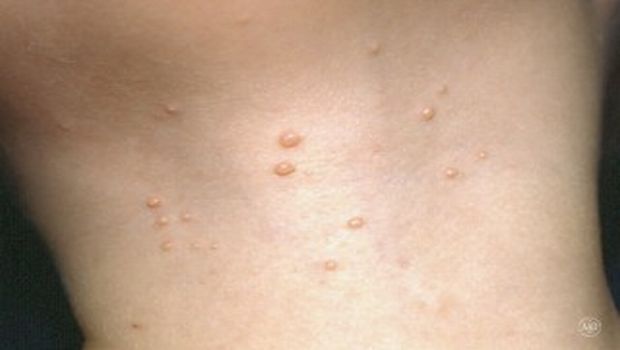Dermatologist Provides Skin Infection Prevention Tips for Athletes
Although many athletes understand the importance of keeping their muscles and bones healthy, it’s also important for them to take care of their skin. Sports equipment, especially protective helmets and pads, creates a warm, moist and dark environment for the germs that can cause skin infections to grow.


Molluscum Contagiosum. Photo courtesy of the American Academy of Dermatology
Although many athletes understand the importance of keeping their muscles and bones healthy, it’s also important for them to take care of their skin. Sports equipment, especially protective helmets and pads, creates a warm, moist and dark environment for the germs that can cause skin infections to grow.
“Athletes are at an increased risk of skin infection, which can have serious consequences and may take them-and their teammates-out of the game for days, weeks or months,” says dermatologist Jeffrey V. Benabio, MD, FAAD, of Kaiser Permanente in San Diego. “If athletes notice anything on their skin that itches, burns or may be infected, they should see a board-certified dermatologist or sports medicine doctor.”
To help prevent skin infections, Benabio recommends that coaches, athletes and athletic trainers follow these tips:
1. Keep cuts and scrapes clean and covered with a bandage until healed. A cut or scrape weakens the skin’s defense and allows germs that cause infections to enter.
2. Prevent blisters to reduce infections. Apply a pad, gel or spray to areas that routinely blister. To help prevent blisters on the feet, ankles and hands, consider using specialized gloves and socks or wearing two pairs of socks. Athletes should also make sure that their footwear fits properly.
3. Wear moisture-wicking clothes. This helps keep the athlete’s skin dry and prevents germs from growing.
4. Wear sandals in the locker room. Wearing sandals or other shoes helps reduce infections on the feet.
5. Shower after every practice and game. In addition, athletes should use an antimicrobial soap and wash their entire body.
6. Do not share personal care items. Athletes should always use a clean towel after showering and use their own towels, soaps, razors and other personal care items.
7. Wash clothes and towels after each use. Sports bags should also be washed, as germs that cause infections can remain in the bags and grow.
8. Disinfect equipment, including protective gear, daily. For proper disinfection, follow the manufacturers’ instructions.
9. Perform regular skin checks. Athletes should check their skin daily, especially those in high-risk sports, such as wrestling. Look for any changes, such as cuts, sores, redness, swelling and pus, and report any changes to an athletic trainer or doctor.
10. Never use sandpaper or bleach to pass a skin check. This will cause more damage to the skin and keep the athlete on the bench longer.
“Without treatment, skin infections can worsen and may spread to other teammates,” says Benabio. “A dermatologist can prescribe effective treatments to help athletes get back in the game.”
These tips are demonstrated in “How to Prevent Skin Conditions in Athletes,” a video posted to the American Academy of Dermatology’s website and the academy’s YouTube channel. This video is part of the Dermatology A to Z: Video Series, which offers relatable videos that demonstrate tips people can use to properly care for their skin, hair and nails. A new video in the series posts to the academy’s website and YouTube channel each month.
Source: American Academy of Dermatology
Gag Order Puts Public Health at Risk, APIC Urges Immediate Action
February 4th 2025APIC warns that the HHS gag order on CDC communications endangers public health, delaying critical infection updates and weakening outbreak response amid rising tuberculosis, avian flu, Ebola, and measles threats.
Breaking Barriers: The Future of HIV Prevention and the Fight for Widespread PrEP Access
January 31st 2025Despite medical advances, HIV prevention faces roadblocks—low PrEP adoption, stigma, and accessibility issues threaten progress. Experts push for innovative, long-acting solutions to end the epidemic.
The Hidden Dangers of Hospital Ventilation: Are We Spreading Viruses Further?
January 31st 2025New research reveals hospital ventilation and air purifiers may unintentionally spread viral particles, increasing infection risks. Infection preventionists must rethink airflow strategies to protect patients and staff.